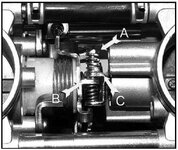Hi all!
Just tried to adjust TPS on 2012 RMK Pro 800. It has brand new 2013 800 engine with just installed "fix kit" on it.
Taking in count all posts describing TPS adjustment, I have disconnected throttle wire, loosened throttle stop screw, and made sure throttle body is fully closed. Then adjusted TPS to 0.7 volts - by loosening TPS screws and rotating it. Then, on MAG side, I have adjusted throttle stop screw to make TPS read 0.94 volts. I have tried it 3 times, but this adjustment gives me 2400 rpm on idle. So, I went other way - by throttle stop screw I have adjusted idle to 1700, and then adjusted TPS to 0.94 volts. Full throttle voltage gives me 4.28 V, so i am happy with this.
What can be wrong with this? Why original adjustment gives me 2400 rpm?
Just tried to adjust TPS on 2012 RMK Pro 800. It has brand new 2013 800 engine with just installed "fix kit" on it.
Taking in count all posts describing TPS adjustment, I have disconnected throttle wire, loosened throttle stop screw, and made sure throttle body is fully closed. Then adjusted TPS to 0.7 volts - by loosening TPS screws and rotating it. Then, on MAG side, I have adjusted throttle stop screw to make TPS read 0.94 volts. I have tried it 3 times, but this adjustment gives me 2400 rpm on idle. So, I went other way - by throttle stop screw I have adjusted idle to 1700, and then adjusted TPS to 0.94 volts. Full throttle voltage gives me 4.28 V, so i am happy with this.
What can be wrong with this? Why original adjustment gives me 2400 rpm?



